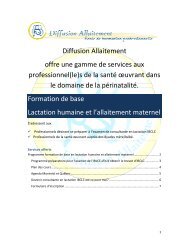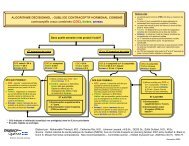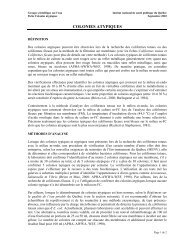Les diagnostics locaux de sécurité - Une étude comparée, pour ...
Les diagnostics locaux de sécurité - Une étude comparée, pour ...
Les diagnostics locaux de sécurité - Une étude comparée, pour ...
You also want an ePaper? Increase the reach of your titles
YUMPU automatically turns print PDFs into web optimized ePapers that Google loves.
TABLE DES MATIÈRES<br />
<strong>Les</strong> <strong>diagnostics</strong> <strong>locaux</strong> <strong>de</strong> <strong>sécurité</strong><br />
<strong>Une</strong> étu<strong>de</strong> <strong>comparée</strong>, <strong>pour</strong> mieux comprendre et mieux agir<br />
LISTE DES TABLEAUX ET FIGURE ................................................................................................ III<br />
INTRODUCTION ................................................................................................................................... 1<br />
Chapitre 1 LA FRANCE : UN CONTRAT LOCAL POUR LA SÉCURITÉ...................................... 5<br />
1.1 <strong>Les</strong> <strong>diagnostics</strong> <strong>de</strong> <strong>sécurité</strong> dans le cadre <strong>de</strong>s contrats <strong>locaux</strong> <strong>de</strong> <strong>sécurité</strong> :<br />
la naissance d’un modèle en France..............................................................................................5<br />
1.2 <strong>Les</strong> contrats <strong>locaux</strong> <strong>de</strong> <strong>sécurité</strong>...................................................................................................... 6<br />
1.3 <strong>Les</strong> <strong>diagnostics</strong> <strong>locaux</strong> <strong>de</strong> <strong>sécurité</strong> ................................................................................................ 7<br />
1.4 <strong>Les</strong> DLS en France : quelques éléments <strong>de</strong> comparaison et d’interprétation................................ 9<br />
1.5 Un cas particulier : le diagnostic <strong>de</strong> <strong>sécurité</strong> <strong>de</strong> l’agglomération <strong>de</strong> Toulouse ........................... 15<br />
Chapitre 2 LE ROYAUME-UNI : UNE STRATÉGIE POUR RÉDUIRE LA<br />
CRIMINALITÉ ET LES INCIVILITÉS........................................................................... 19<br />
2.1 <strong>Une</strong> loi contre le crime et les incivilités......................................................................................19<br />
2.2 De nouveaux partenariats ............................................................................................................ 21<br />
2.3 La stratégie gouvernementale...................................................................................................... 22<br />
2.4 <strong>Une</strong> boîte à outils <strong>pour</strong> réduire le crime et les incivilités............................................................ 22<br />
2.5 <strong>Les</strong> audits anglais : quelques éléments <strong>de</strong> comparaison et d’interprétation................................ 24<br />
2.6 Un cas particulier : l’audit <strong>de</strong> Southampton City ........................................................................ 27<br />
2.7 <strong>Une</strong> première évaluation <strong>de</strong>s audits anglais ................................................................................ 29<br />
Chapitre 3 LA BELGIQUE : DES CONTRATS ET DES ÉVALUATIONS<br />
SANS DIAGNOSTICS..................................................................................................... 31<br />
3.1 La politique <strong>de</strong> prévention en Belgique : un peu d’histoire ........................................................ 31<br />
3.2 <strong>Les</strong> « nouveaux » contrats........................................................................................................... 32<br />
Chapitre 4 L'AUSTRALIE : LES ENQUÊTES LOCALES DE SÉCURITÉ .................................... 35<br />
4.1 L’organisation <strong>de</strong>s politiques <strong>de</strong> prévention et <strong>sécurité</strong> en Australie.......................................... 35<br />
4.2 Du diagnostic à l’enquête <strong>de</strong> <strong>sécurité</strong>.......................................................................................... 36<br />
Chapitre 5 LA NOUVELLE-ZÉLANDE : LES PROFILS LOCAUX DE SÉCURITÉ .................... 43<br />
5.1 L’organisation <strong>de</strong> la politique <strong>de</strong> prévention............................................................................... 43<br />
5.2 <strong>Les</strong> profils du crime et <strong>de</strong> la <strong>sécurité</strong> : l’exemple <strong>de</strong> la ville d’Auckland ................................... 44<br />
5.3 Audit « communautaire » dans la ville <strong>de</strong> Hutt : une approche basée sur<br />
l’aménagement environnemental ................................................................................................ 48<br />
5.4 Facteurs <strong>de</strong> risque, facteurs <strong>de</strong> protection d’entrée dans la délinquance..................................... 50<br />
Chapitre 6 ASPECTS COMPARATIFS ET TRANSVERSAUX ENTRE LES MODÈLES ............ 55<br />
6.1 Brève comparaison entre le modèle anglais et le modèle français <strong>de</strong> diagnostic........................ 55<br />
6.2 Analyse transversale <strong>de</strong>s modèles ............................................................................................... 56<br />
6.3 <strong>Les</strong> <strong>diagnostics</strong> et la statistique criminelle : une remarque nécessaire........................................ 59<br />
6.4 Un début <strong>de</strong> conclusion............................................................................................................... 61<br />
Chapitre 7 DIAGNOSTIC DE SÉCURITÉ : VERS UN POSSIBLE MODÈLE? ............................. 63<br />
7.1 Caractéristiques du diagnostic <strong>de</strong> <strong>sécurité</strong>................................................................................... 63<br />
7.2 Étapes <strong>de</strong> la réalisation du diagnostic <strong>de</strong> <strong>sécurité</strong> ....................................................................... 64<br />
7.3 Deux remarques finales............................................................................................................... 72<br />
Institut national <strong>de</strong> santé publique du Québec I<br />
Centre international <strong>pour</strong> la prévention <strong>de</strong> la criminalité<br />
Ministère <strong>de</strong> la Sécurité publique du Québec












